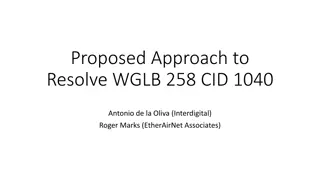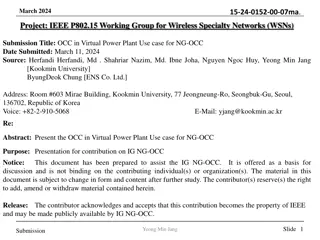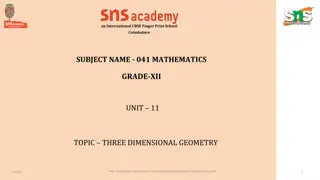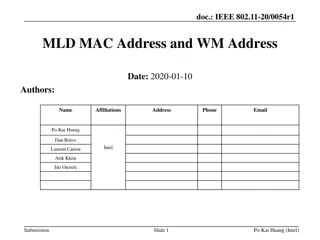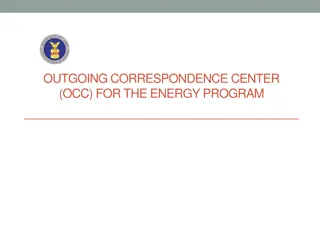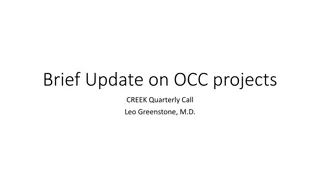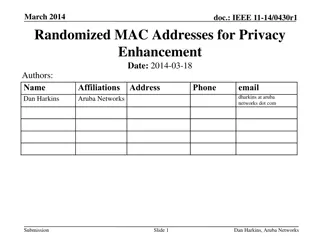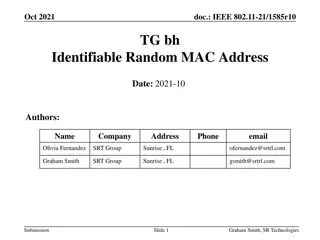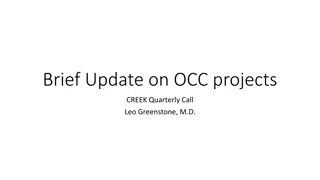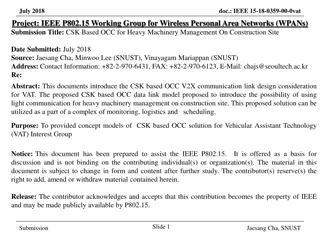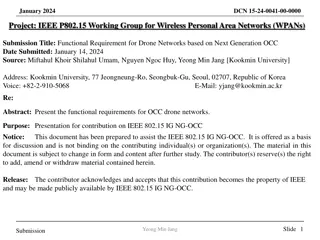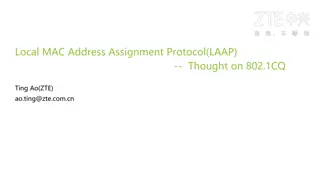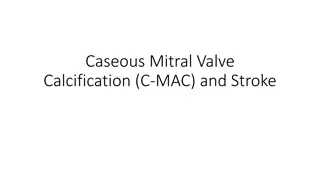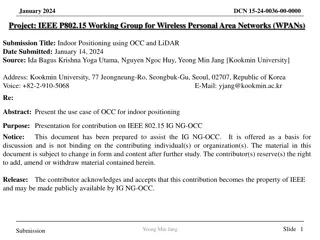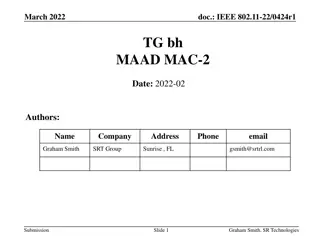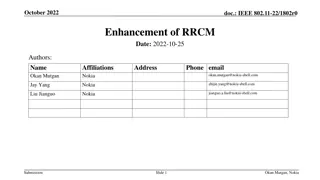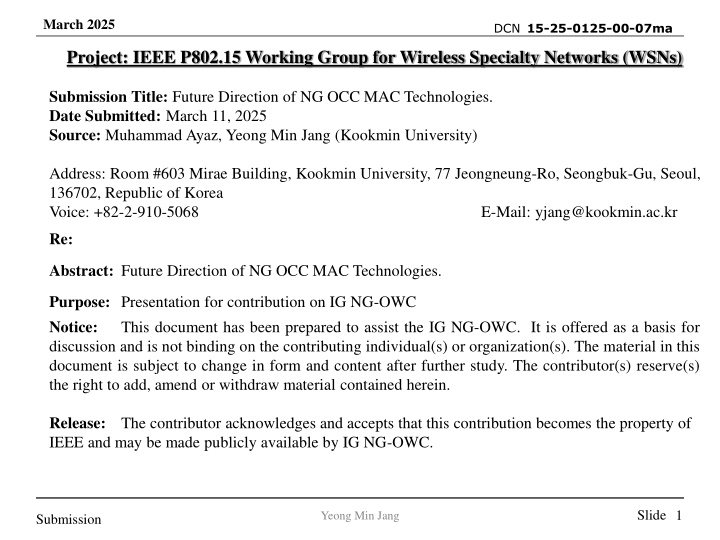
Future Trends in Optical Camera Communication MAC Technologies
Explore the evolution of MAC protocols in Optical Camera Communication (OCC) networks, focusing on enhancing data transfer, power efficiency, and hybrid integration with RF technology for seamless communication. Learn about the challenges and advancements in managing access to the shared communication medium to prevent collisions and interference.
Download Presentation

Please find below an Image/Link to download the presentation.
The content on the website is provided AS IS for your information and personal use only. It may not be sold, licensed, or shared on other websites without obtaining consent from the author. If you encounter any issues during the download, it is possible that the publisher has removed the file from their server.
You are allowed to download the files provided on this website for personal or commercial use, subject to the condition that they are used lawfully. All files are the property of their respective owners.
The content on the website is provided AS IS for your information and personal use only. It may not be sold, licensed, or shared on other websites without obtaining consent from the author.
E N D
Presentation Transcript
March 2025 DCN 15-25-0125-00-07ma Project: IEEE P802.15 Working Group for Wireless Specialty Networks (WSNs) Submission Title: Future Direction of NG OCC MAC Technologies. Date Submitted: March 11, 2025 Source: Muhammad Ayaz, Yeong Min Jang (Kookmin University) Address: Room #603 Mirae Building, Kookmin University, 77 Jeongneung-Ro, Seongbuk-Gu, Seoul, 136702, Republic of Korea Voice: +82-2-910-5068 E-Mail: yjang@kookmin.ac.kr Re: Abstract: Future Direction of NG OCC MAC Technologies. Purpose: Presentation for contribution on IG NG-OWC Notice: This document has been prepared to assist the IG NG-OWC. It is offered as a basis for discussion and is not binding on the contributing individual(s) or organization(s). The material in this document is subject to change in form and content after further study. The contributor(s) reserve(s) the right to add, amend or withdraw material contained herein. Release: The contributor acknowledges and accepts that this contribution becomes the property of IEEE and may be made publicly available by IG NG-OWC. Slide 1 Yeong Min Jang Submission
March 2025 DCN 15-25-0125-00-07ma Future Direction of NG OCC MAC Technologies March 11, 2025 Slide 2 Yeong Min Jang Submission
March 2025 DCN 15-25-0125-00-07ma Contents Background Physical layer specifications Comparison of various IEEE standards for NG OCC. Conclusion References Slide 3 Yeong Min Jang Submission
March 2025 DCN 15-25-0125-00-07ma Background Optical Camera Communication (OCC) is a type of wireless communication that uses visible light, infrared, or ultraviolet light emitted from LEDs or other light sources as the communication medium. Optical Wireless Communication (OWC) leverages light waves to transmit data, offering advantages such as high capacity, security, and an unlicensed spectrum. Multiple transmitters (e.g., LEDs, displays) might aim to communicate with one or more cameras on a shared communication medium, but without a suitable protocol, transmitters could send data simultaneously, leading to data collision and interfrenece. MAC protocol is like a set of traffic rules for communication. In any communication system where multiple devices might want to use the same communication medium. MAC protocol is essential to manage access to that medium and prevent Collision and interference. Slide 4 Yeong Min Jang Submission
March 2025 DCN 15-25-0125-00-07ma Continue Medium Access Control (MAC) Layer (802.15.7-2011 and 2018) Basic MAC: CSMA/CA is fundamental, similar to other 802.15 standards. Addressing: Defines addressing schemes for devices in the OWC network. Power Saving: Mechanisms for low-power operation, crucial for IoT applications. Duty cycling, sleep modes, etc. Data Transfer and Control: Frame formats for data and control information. Quality of Service (QoS): Basic QoS mechanisms may have been defined, but not a primary focus in the initial standards. Medium Access Control (MAC) Layer (802.15.7-2024) High Data Rates and Throughput: Efficient MAC to manage Gbps and beyond data rates. Mobility Support: MAC protocols designed to handle mobile nodes and dynamic environments Hybrid RF-OWC Integration: MAC protocols that can efficiently manage and coordinate hybrid RF-OWC networks. Slide 5 Yeong Min Jang Submission
March 2025 DCN 15-25-0125-00-07ma Physical layer specifications IEEE 802.15.7-2011: Modulation: Primarily On-Off Keying (OOK), Pulse Position Modulation (PPM), and Color Shift Keying (CSK). Designed for intensity modulation and direct detection (IM/DD) in VLC. Data Rates: Relatively low, ranging from kbps to a few Mbps, depending on the modulation and configuration. Focused on reliable, low-complexity communication. Channel Access: CSMA/CA (Carrier Sense Multiple Access with Collision Avoidance). Frequency Bands: Visible light spectrum (typically defined by LED emission wavelengths) Slide 6 Yeong Min Jang Submission
March 2025 DCN 15-25-0125-00-07ma Physical layer specifications IEEE 802.15.7-2018: Modulation: Carried over modulations from 2011 (OOK, PPM, CSK) and added more advanced modulation schemes to enhance data rates and efficiency for both VLC and OCC. Included higher-order modulation schemes and adaptive modulation techniques. Incorporated specifications for OCC, considering rolling shutter and frame-based nature of cameras Data Rates: Expanded data rates significantly, potentially reaching tens of Mbps, depending on the modulation and OWC modality (VLC vs. OCC, etc.). Aimed for higher throughput to support broader applications. Channel Access: CSMA/CA, with enhancements and potentially more sophisticated MAC protocols to handle diverse OWC scenarios. Frequency Bands: Visible light spectrum and also defined specifications for OCC using camera frame rates and pixel modulation Slide 7 Yeong Min Jang Submission
March 2025 DCN 15-25-0125-00-07ma Physical layer specifications IEEE 802.15.7-2024: Modulation: More advanced modulation schemes to push for Gbps data rates. OFDM (Orthogonal Frequency Division Multiplexing) and its variants: Common in RF and becoming more relevant in OWC research for its spectral efficiency and robustness against channel impairments. Advanced CSK and Multi-dimensional Modulation: Further development of CSK and potentially exploring higher-dimensional modulation techniques to maximize spectral efficiency and data rates in the visible light domain Data Rates: Targeting Gigabit-per-second (Gbps) and beyond data rates for certain OWC scenarios, especially for short-range, high-throughput applications. Channel Access: More advanced MAC protocols to manage interference, support QoS (Quality of Service) for diverse applications, and efficiently handle the characteristics of different OWC links (VLC, OCC). Frequency Bands: Continued focus on visible light and camera-based optical bands. Slide 8 Yeong Min Jang Submission
March 2025 Comparison of various IEEE standards for NG OCC. DCN 15-25-0125-00-07ma Feature IEEE 802.15.7-2011 IEEE 802.15.7-2018 OWC (VLC, OCC, etc.) Expanded OWC Applications Enhanced Modulations, OCC Support Tens of Mbps IEEE 802.15.7-2024 Advanced OWC, Potential 6G Integration Enhanced IoT, Industrial, AR/VR, 6G Core Focus VLC Target Applications Indoor, Low Data Rate Advanced Modulations (OFDM, etc.), Gbps Data Rates PHY Layer OOK, PPM, CSK Data Rates kbps - Mbps Gbps and Beyond Advanced MAC, QoS, Mobility, Hybrid OWC/RF Advanced Security, Lightweight Crypto, Physical Layer Security? Short-to-Medium Range (Research Focus) Ultra-Low Power (Research Focus) Higher Cost Reduction Focus MAC Layer Basic CSMA/CA Enhanced MAC Enhanced Security Security Basic Security Range Short-Range Short-Range Power Consumption Energy Efficient Energy Efficient Complexity Cost Lower Low Medium Medium Slide 9 Yeong Min Jang Submission
March 2025 DCN 15-25-0125-00-07ma Conclusion OCC Capabilities Further Focusing on: Higher Data Rates: Exploring advanced modulation schemes, multiplexing techniques in both VLC and OCC to meet demands for higher bandwidth applications. Mobility improvement: Addressing challenges related to mobility in OCC systems, enhancing link stability and performance in dynamic environments. Energy Efficiency and Power Management: Crucial for IoT applications, potential focus on ultra-low-power OWC implementations. Security Enhancement: Addressing specific security challenges in OWC, especially with broader applications in IoT and industrial settings. Slide10 Yeong Min Jang Submission
March 2025 DCN 15-25-0125-00-07ma References [1] Alawadhi, A., Almogahed, A., & Omar, M. H. (2023). A Survey on IEEE 802.15.7 MAC Protocols for Visible Light Communication. 2023 1st International Conference on Advanced Innovations in Smart Cities (ICAISC), 1 6. https://doi.org/10.1109/icaisc56366.2023.10085558 [2] Che, F., Wu, L., Hussain, B., Li, X., & Yue, C. P. (2016). A fully integrated IEEE 802.15.7 visible light communication transmitter with On-Chip 8-W 85% efficiency boost LED driver. Journal of Lightwave Technology, 34(10), 2419 2430. https://doi.org/10.1109/jlt.2016.2535319 [3] IEEE Standard for Local and Metropolitan Area Networks - Part 15.7: Short-Range Optical Wireless Communications Amendment 1: Higher Rate, Longer Range Optical Camera Communication (OCC). (2024). IEEE Computer Society. https://doi.org/10.1109/ieeestd.2025.10884983 [4] Sarbazi, E., & Uysal, M. (2013). PHY layer performance evaluation of the IEEE 802.15.7 visible light communication standard. 2013 2nd International Workshop on Optical Wireless Communications (IWOW), 35 39. https://doi.org/10.1109/iwow.2013.6777772 [5] IEEE Standard for Local and metropolitan area networks--Part 15.7: Short-Range Optical Wireless Communications. (2018). IEEE Computer Society. https://doi.org/10.1109/ieeestd.2019.8697198 [6]Faridh, M. M., Herfandi, H., Sitanggang, O. S., Nasution, M. R. A., Nguyen, H., & Jang, Y. M. (2025). Implementation of CSMA/CA-based MAC protocol for optical camera communication. IEEE Access, 1. https://doi.org/10.1109/access.2025.3531198 [7] Sitanggang, O. S., Nguyen, V. L., Nguyen, H., Pamungkas, R. F., Faridh, M. M., & Jang, Y. M. (2023). Design and implementation of a 2D MIMO OCC system based on deep learning. Sensors, 23(17), 7637. https://doi.org/10.3390/s23177637 Slide 11 Yeong Min Jang Submission

